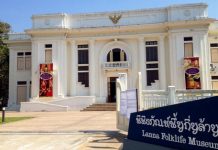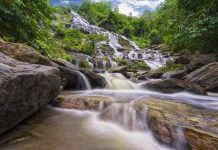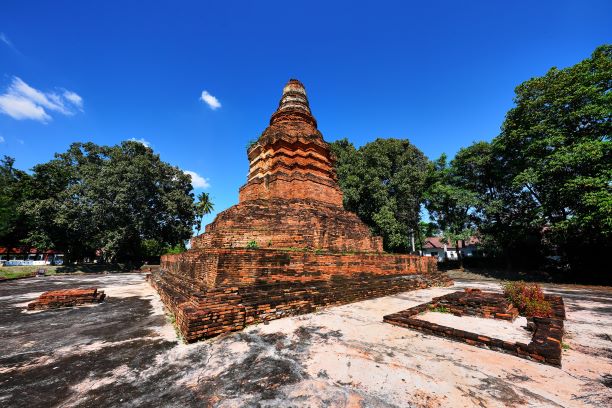
Wiang Kum Kam, the Underground Ancient City
Flashback to the past via the journey to the ancient town of Lanna “Wiang Kum Kam“. Explore to the former capital of the Lanna Kingdom in the reign of King Mangrai, the founder of this splendid and historical city with ages more than seven centuries. Indeed, the place is a must-not-miss for your trip to Chiang Mai.
Wiang Kum Kam has been well-known for long period of time since the discovery of the Department of Fine Arts of which the pieces of the baked clay Buddha amulet by the Hariphunchai artisan (Lamphun) in the excavation at Wat Karn Thom site (Wat Chang Kham) in 1984. And the survey has proceeded from time to time, later.
About the place
During the year 1984 – 2003 which is about 20 years in a total that the Department of Fine Arts had studied the history of this old city. Lots of evidence included antiques and architectures unclouded the existing of “Wiang Kum Kam”, explicitly. In particular, the discovery in late 2002 that founded the sculpture of “Makara with the Naga” (the mythology creatures in Hindu and Buddhist culture) at Wat Gu Pa Dom and the china that buried under the bottomland around the area of Wat Nan Chang.
Although those pieces of evidence are not enough to conclude about Wiang Kum Kam perfectly, they are good enough to be the first path to link whom may interested in the history of this lost city.
Where is Wiang Kum Kam
The ancient city of Wiang Kum Kam currently stands in the middle of the old Mae Ping and the new Mae Ping river which is about 5 km distant from Chiang Mai town to the south. The site is in Tha Wang Tan, and Nong Phueng sub-district of Saraphi district included Pa Daet and Nong Hoi sub-district of Muaeng district in Chiang Mai which covers approximately 3 sqm capacity of space.
The first capital of the Lanna Kingdom
With the long history, Wiang Kum Kam is considered as the first capital of the Lanna Kingdom that was established in the age of King Mangrai or between 1386 – 1295. The king purposed to set this place as the administrative center of the kingdom. He did the trading with neighboring states and also issue a law to rule the land which called “Mangraithammasat”. Consequently, Wiang Kum Kam was another community with living happily and prosperity at that time.
The Glory of Wiang Kum Kam
Witness from the remaining objects of Wiang Kum Kam, then we would see the unique beauty of those edifices. The example includes, “the squared chedi” or Wat Gu Kham, a temple with the exotic and elegant pagoda that was created by King Mangrai in 1288. The most outstanding thing of the temple is the squared pagoda in Hariphunchai art which is the primary sacred object at the site.
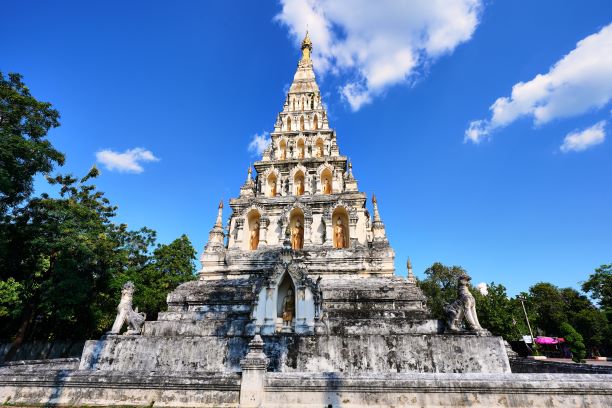
An arranged 5-tier square shaped of chedi with the pyramidal roof. Each level furnished with the arches to enshrine the standing Buddha images in various attitudes which are 3 arches for each side in total about 60 frames.
Moreover, there is the magnificent fresco art decorated around the pagoda. So, the architectural of art at Wat Gu Kham very splendid for the tourist to inspect. Further, there are the fabulous architectures in other temples that are not less in the beauty that you should not miss, as well.
The Fall of Wiang Kum Kam

The city of Wiang Kum Kam reached its esteem glory, unfortunately, due to the remarkable float the old capital of Lanna collapsed and submerged under the sludge. Also, the change of Mae Ping river that does not run through Wiang Kum Kam as before. Thence, the dwellers gradually left the city and wholly collapsed once Burmese troops herded the rest of the people to be their prisoner of the war. And Wiang Kum Kam was buried under the 2 meters ground and became the myth of Lanna since then.
Rediscover of Wiang Kum Kam
In 1984, the surveyor unit 4 of the Department of Fine Arts came to the base at Wat Chang Kham to excavate “Karn Thom Vihara” resulted in the archeologists’ further studies about the lost city. The intensive education and research together with the objects of the evidence founded within the survey site at Moo 11 Village, Tha Wang Tan in Saraphi district convinced that the location is the former capital of Lanna “Wiang Kum Kam”.
Therefore, the surveyors proceeded the excavation and developed the landscape of the site in order to introduce the place as a new tourist attraction. Metaphor, it is the resurrection of Wiang Kum Kam of Lanna.
The Must Not Miss Sightseeing
Based on the survey, it founded that there are more than 40 sites of attractions within Wiang Kum Kam in both of ancient remains and temples with the monks. The historic sites including Wat Chedi Liam, Wat Chang Kham, and the ruined pagoda of Wat Kum Kam, Wat Noi, Wat Pu Pia, Wat That Khao, and Wat E-Khang. The design of art and architecture present in both of classic and the glory Chiang Mai, especially at Wat That Khao with the myth noted that the consort of King Mangrai became the Buddhist nun and dead here.
It mentioned that the reason that she was ordained is King Mangrai got new consort from the battleship with Burma. After the king conquered the opponent, Burma yielded and offered “Princess Pai Kho” to be his consort. The queen bewailed from this since King Mangrai, and she used to make the vow when they resided in Chiang Saen that the king will have only her as the consort. With mourn then the queen fled to become the nun. Moreover, another story noted that King Mangrai was killed by the thunderbolt during his visiting to the market caused from he broke the vow.
Highlights of the Place
Well, now we would introduce you to the numbers of exciting places at Wiang Kum Kam. Let's go!
- Wiang Kum Kam Information Center:
The first stop for the visitors of Wiang Kum Kam should check-in. Wiang Kum Kam Information Center is the place that collects all related information of this legendary town included museum and souvenir shop.
The museum allocated into 5 exhibition halls which are
- Industrial Museum – exhibition about the native handicrafts
- History – background of Wiang Kum Kam
- Lecture room – presents the summary information of Wiang Kum Kam via video presentation
- About Wiang Kum Kam – presents the notable information of Wiang Kum Kam
- Music Instruments – displays the variety of Lanna music instruments
1. Wat Chang Kham (Wat Karn Thon):
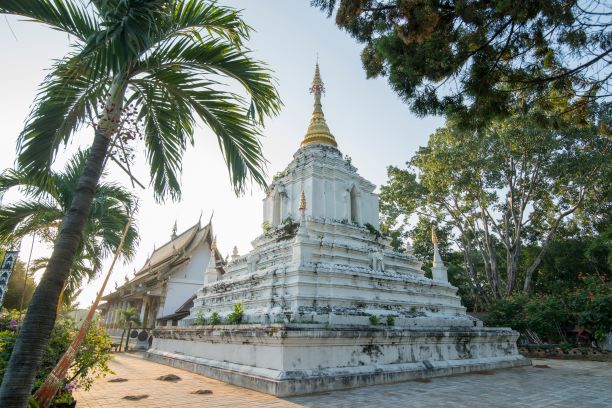
The temple locates at Moo 11, Tha Wang Tarn in Saraphi district. It assumed that it is the same temple “Wat Karn Thon” that King Mangrai commanded the craftsman named “Karn Thom” to bring the woodcraft from Chiang Saen to build the sanctuary. According to the excavation and restoration by the Department of Fine Art in 1984 founded that there are 2 categories of the old remain here.
First, the building that built before the reign of King Mangrai, and another is the historic site that created in the period of Wiang Kum Kam. Nowadays, there are the sanctuary and the squared shaped pagoda with the pyramidal roof situated over the low gallery and the old baked clay Buddha images that would be interesting for the tourists to experience.
2. Wat That Khao:
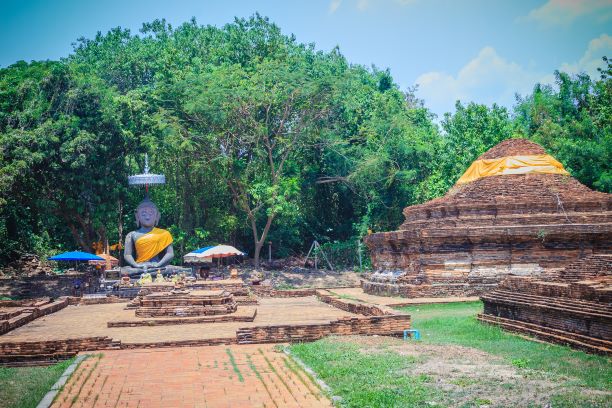
The holy place situates at Tha Wang Tarn in Saraphi district. As the old temple, the site was assumed that it existed before the establishment of Wiang Kum Kam. The title of the temple “Wat That Khao” (the White pagoda) derived from the pagoda is originally white-washed; however, it is only the platform remains with 2 tiers of the lotus shape. Moreover, it also the discovery of the base of a sanctuary, a little chapel, and an ubosot and in the same area there is the Buddha image that allows to the public to make the worship, too.
3. Wat Pu Pia:

Another interesting temple in Wiang Kum Kam which locates in Tha Wang Tarn, Saraphi district and it’s just only 200 meters from Wat That Khao. It assumed that the holy place was built in the Wiang Kum Kam era. Presently, the spot features the ancient remains including the main pagoda, sanctuary, ubosot, satellite stupas (Gu), and the altar.
4. Wat E-Khang:
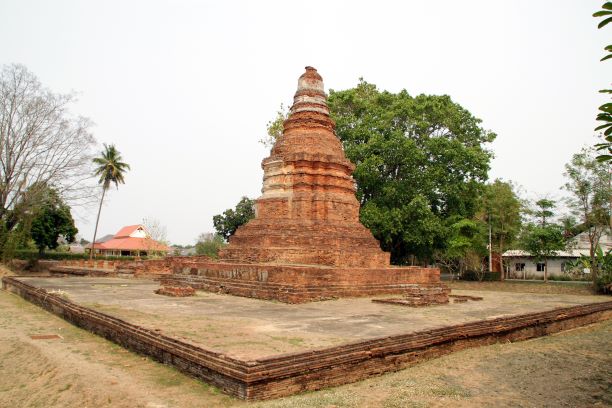
Only 200 meters distant from Wat Pu Pia, Wat E-Khang, is another Wiang Kum Kam’s attraction in Tha Wang Tarn in Saraphi district that you should not miss. Based on the evidence, the temple might be the vital temple of Wiang Kum Kam resulted from the constructions at the site are immense whether vihara or the main pagoda.
In particular, the Vihara with the dimension is 13.50 x 20.00 m which are masonry building, unluckily it is only the platform part exists. The main chedi which is a bell-shaped pagoda stands over the high balcony with the staircase in the east and the west of the structure. The pagoda considered as one of the magnificent pagodas of Wiang Kum Kam.
5. Wat Nan Chang:
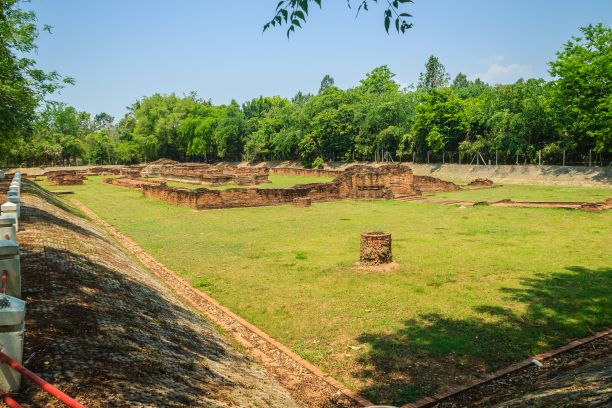
The temple also sites at Tha Wang Tarn sub-district. After the discovery, it founded that lots of historic sites at the venue included an extraordinary presence of Monthop (the squared building with the pyramidal roof). Only can see at the location, the structure contains 4 groups of pillars which is 4 columns for each. Apart from that, the place stored the notable antique which is “the White Pottery” presented in the same style of the Ming Dynasty’s Chinaware. So, that is to say, that it’s a must not miss location to visit for your Wiang Kum Kam trip, indeed.
The excavation at the archeological site at Wat Nan Chang during October 25 – 28, 2003 discovered 2 categories of the Chinaware about 55 units in total.
The first Group:
The first category is 8 units of the saucer with the blue painting in mint condition. The pattern was sorted into 2 styles are “Rock Garden” 4 units and “China Swan” 4 units. They were piled up beneath the bottomland at the brae in the west of the dike in front of Wat Nan Chang. At the bottom of the ground founded the mingle of slag and other organic matter. Followed to the appearance and location showed that these wares were tied or packed inside the crate and they might descend from the top of the dike which assumed the residence caused by the area is nearby the evidence of pond.
The Second Group:
The second group which founded inside the jar with brown lacquer that buried under the ground approximately 1.30 – 1.50 meters deep. There is the pile of the brick between the pot and sand in the surrounding area. The jar sealed with the bronze tray and 3 bars of the block contained China and bronze appliances about 51 units in total. Most of the china is in the mint condition with the design of blue painting under the lacquer and the picture of animals and plants in yellow, red, green, blue, and brown. Lots of them engraved with the Chinese alphabets and one of them displays the importance of the owner, also the relationship between the Lanna Kingdom and China that has never appeared in any annals of Lanna.
Notwithstanding, Wiang Kum Kam as mentioned previously has a lot of more impressive temples and the historic sites that are all the must-not-miss for the tourists. The best chance for you to travel back to the past to learn the story and the civilization of the ancient Lanna at this archeological site.
Taking the Tour
Wiang Kum Kam opens for the public between 7.00am – 6.00pm daily. The admission fee is THB10 per each (for the foreigner, please feel free to ask for the rate at the entrance). The place allows the visitor to self-survey by personal vehicle; alternatively, the horse carriage serviced by the Wiang Kum Kam Information Center is available for the tourist with THB300 for 2 persons with the touring duration time approximately 45 minutes.
How to Get there
By Car, from Central Airport Chiang Mai, drives along the highway route Chiang Mai – Lamphun to Saraphi district. When you arrive at 700 Years Chiang Mai Road (the rural road number 3029) make the right turn to Tha Wang Tarn sub-district. Wiang Kum Kam Information Center is on the roadside.
For whom without the personal vehicle, you can get the blue pick-up truck service route Chiang Mai – Lamphun and gets off at the Provincial Police Station at Mae Ping sub-district and contact the Wiang Kum Kam Information Center to send the horse carriage to pick you up for the tour.

